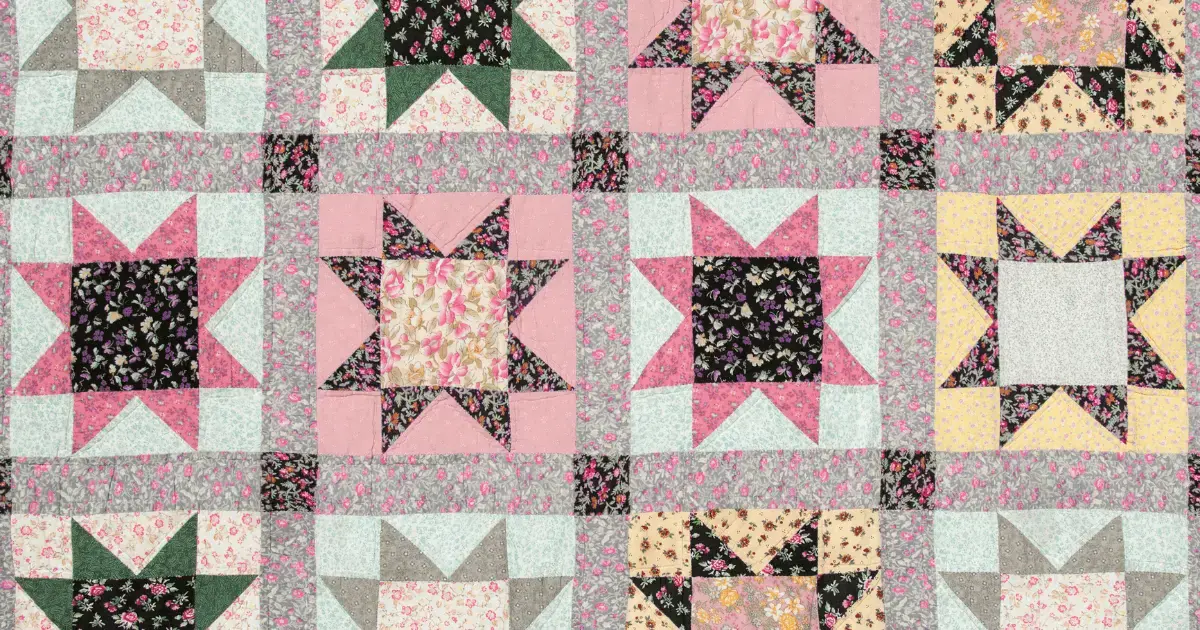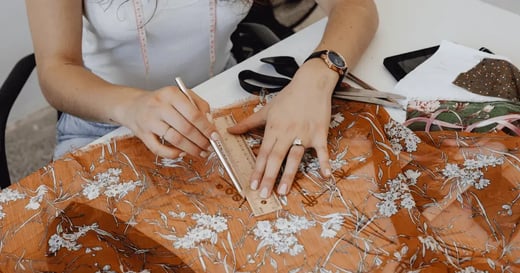
Behind every quilt shop is someone pouring their heart into the details — choosing fabrics, helping customers find just the right colors, and keeping the doors open through both the busy seasons and the slow ones.
But sometimes, the numbers don’t quite add up. Fabric costs climb, foot traffic dips in the summer, and online competition never seems to take a day off.
That’s why more quilt shops now lean on block-of-the-month quilt programs.
A good block-of-the-month program gives your customers something to look forward to, keeps them coming back month after month, and helps you smooth out your cash flow. Done right, it can turn casual shoppers into a quilting community (and pay the bills along the way).
Let’s break down why quilters love them, why quilt shops benefit, and how to make your program run smoothly without turning it into a full-time job.
What Exactly Is a Block-of-the-Month Quilt Program?
If you’ve never run one, it’s simpler than it sounds.
Instead of selling a full quilt kit all at once, you break the project into smaller monthly pieces. Each month, participants receive the fabric and instructions for just one block.
By the end of nine to 12 months, they have everything they need to sew the quilt top.
Many shops also offer optional finishing kits for sashing, borders, backing, and batting — extra add-ons that boost sales and help quilters finish strong.
The real magic is that it feels approachable. Instead of staring at a big stack of fabric and feeling overwhelmed, quilters can take it one block at a time. And instead of shelling out a large amount upfront, they pay in smaller chunks that fit their budget.
Why Quilters Love Block-of-the-Month Programs
Sure, signing up means buying fabric — but it also offers encouragement, inspiration, and the joy of being part of a like-minded community.
Ask any quilter why they stick with block-of-the-month, and you hear the same themes again and again:
- It’s manageable: One block a month feels doable, even with a busy schedule.
- It’s affordable: Spreading the cost out over the year is easier than paying all at once.
- It’s social: Many programs include sew-alongs, private groups, and in-store meetups.
- It’s exciting: Opening the monthly kit feels like unwrapping a present.
And for newer quilters, a block-of-the-month program doubles as a class. They learn step by step without the overwhelm. By the time they finish, they have both a beautiful quilt and the skills to tackle the next project with confidence.
Why Quilt Shops Benefit From Block-of-the-Month Programs
Running a quilt shop is unpredictable. Some months are busy, while some months feel slow.
Here are a few of the biggest ways block-of-the-month programs support your shop:
- Predictable cash flow: Monthly payments keep money coming in, even during slower seasons.
- Regular visits: Customers have a reason to stop by each month (and they might just buy a little extra).
- Better fabric turnover: Instead of bolts gathering dust, you move fabric consistently.
- Stronger relationships: Monthly check-ins give you time to build trust and loyalty.
Even if other sales fluctuate, block-of-the-month programs keep your shop steady. Plus, seeing participants return month after month builds a sense of community that can ripple out into other sales, classes, and events.
Related Read: Why and How To Start a Loyalty Program for Your Sewing Store
How To Price a Block-of-the-Month Program
Pricing is where a lot of shop owners hesitate. Charge too little and you lose money. Charge too much and customers may walk away.
Here are some price ranges that work:
- Basic programs: $15–$20 per month. This is great for simple sampler quilts or smaller blocks.
- Midrange programs: $25–$35 per month. This is a common sweet spot for nice fabrics and patterns.
- Premium programs: $40–$50 per month. These often feature designer fabrics, batiks, or custom patterns.
When figuring out your price, don’t forget to include:
- Fabric
- Labor for cutting and packaging
- Pattern or licensing fees
- Packaging materials
And most importantly, be clear. Let customers know exactly what’s included in the monthly price. If the finishing kit costs extra, say so upfront. People are much happier when they know what to expect.
Common Problems (& How To Avoid Them)
Every program hits snags now and then.
These are the most common challenges and how to handle them:
- Running out of fabric: Nothing frustrates quilters more than a midyear substitution, especially if they were dreaming of a specific color or pattern.
- The fix: Plan ahead by reserving enough fabric for the entire program before launch. Track inventory carefully and consider ordering a little extra to cover mistakes or special requests.
- Late kits: Delayed shipments or cutting schedules can kill momentum and disappoint your participants.
- The fix: Start cutting blocks ahead of time and build in a buffer for unforeseen delays. Communicate clearly with participants if anything unexpected happens.
- Tricky instructions: Confusing patterns can discourage beginners and slow down quilters.
- The fix: Test each block before sending it out, and provide multiple ways to follow along — written instructions, diagrams, or a short video demo. Encourage questions and create a space where participants can share tips and ask for help.
- Dropouts: Some participants inevitably fall behind or feel overwhelmed, which can lead to quitting mid-program.
- The fix: Offer catch-up kits, gentle reminders, and regular encouragement. Celebrate milestones — like completing a tricky block or finishing a quarter of the quilt — to keep motivation high.
Tips for Keeping Participants Engaged
Here’s the part most shop owners underestimate — retention.
It’s normal for 20–30% of participants to drop out of long programs. But you can cut that number way down with a few strategies:
- Host monthly meetups — whether in store or online — to give quilters a reason to stay on track.
- Celebrate progress by displaying finished blocks on a community board or sharing them on social media.
- Offer small rewards — even something as simple as a free fat quarter for on-time pickups can help members stay engaged.
- Pair participants up so they have accountability buddies who encourage each other to stick with the program.
The more connected quilters feel, the more likely they are to finish and sign up again next time.
Best Times To Launch a Block-of-the-Month Quilt Club
Timing matters. Launching at the wrong time can make it tough to fill spots, so thinking about the rhythm of your customers’ year can have a big impact.
The sweet seasonal spots tend to be:
- January: Fresh-year energy and resolutions have quilters ready to dive into a new project.
- September: Back-to-school schedules leave many looking for a bit of personal creative time to recharge.
Try to steer clear of May and June, when summer plans start to take over. Some shops get around this by running nine-month programs that finish before summer, while others build in a midyear catch-up month to give participants extra flexibility.
Planning around these natural rhythms keeps interest high and helps your program stay full, engaging, and fun from start to finish.
How To Manage Inventory
If there’s one area to overprepare for, it’s fabric. Running out midyear is the fastest way to upset participants.
Here are a few best practices:
- Allocate fabric for the entire program before it starts.
- Cut in advance when possible so you’re not scrambling each month.
- Store kits in a clearly labeled, organized system.
- Order 5–10% more fabric than you think you’ll need.
This way, you can breathe easy knowing you won’t have to scramble for a substitute print six months in.
How Technology Simplifies Block-of-the-Month Programs
If you’ve ever run a block-of-the-month program the old-fashioned way, you know how chaotic it can get.
You’re scribbling pickup reminders on sticky notes, digging through binders to see who’s paid, and crossing your fingers that you don’t run out of fabric halfway through. It works, but it’s exhausting.
Now picture the same program with a little help from technology:
- Payments run automatically, so you don’t have to chase checks or send awkward reminders.
- Pickups are tracked for you, so you instantly see who has their kit and who might need a quick nudge.
- Fabric is reserved from day one, so you have no more midyear substitutions or disappointed faces.
- Setup is flexible, whether you want to run a 6-, 9-, or 12-month program.
- Reports are one click away, so you can see revenue, participation, and retention at a glance.
With the busywork off your plate, you get to spend more time on the fun stuff.
Related Read: Quilt Store POS System: 10 Benefits & Top Providers
Make Running Block-of-the-Month Programs Easy With Like Sew
Trying to track a block-of-the-month program on paper can spiral out of control before you know it.
That’s where Like Sew comes in.
It’s an all-in-one point of sale (POS) system built for quilt and sewing shops, so the tools feel like they were made with your world in mind. Here’s how:
- Stay on top of billing: Set up automatic monthly payments so you don’t have to chase anyone down. Want to collect a sign-up deposit? Easy. Prefer to offer a house account to your best customers? You can do that, too.
- Build kits without second-guessing: Put together monthly kits in minutes and see exactly what fabric is in stock, what’s already spoken for, and what still needs to be cut.
- Keep your quilters excited: Organize rosters for meetups or sew-alongs, and send friendly nudges with built-in email and text reminders.
- Sell wherever your customers shop: Make sure your inventory stays synced automatically, whether your customers shop in-store or order from your e-commerce website.
- Know what’s working: Run quick reports or schedule them to hit your inbox. Track customer history and sync sales to QuickBooks so your books stay neat.
If you want to see how it works firsthand, schedule a demo today.


 by
by 







